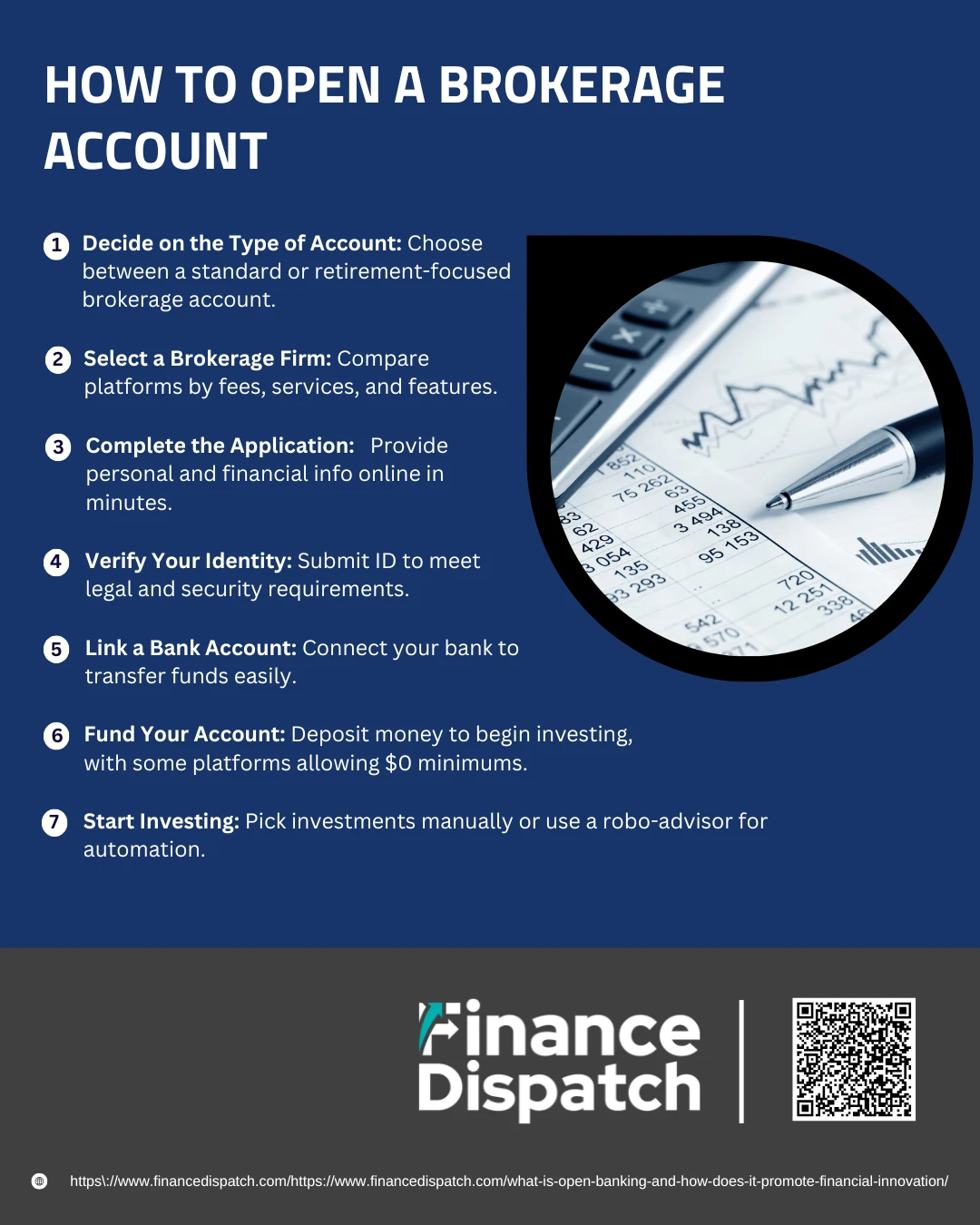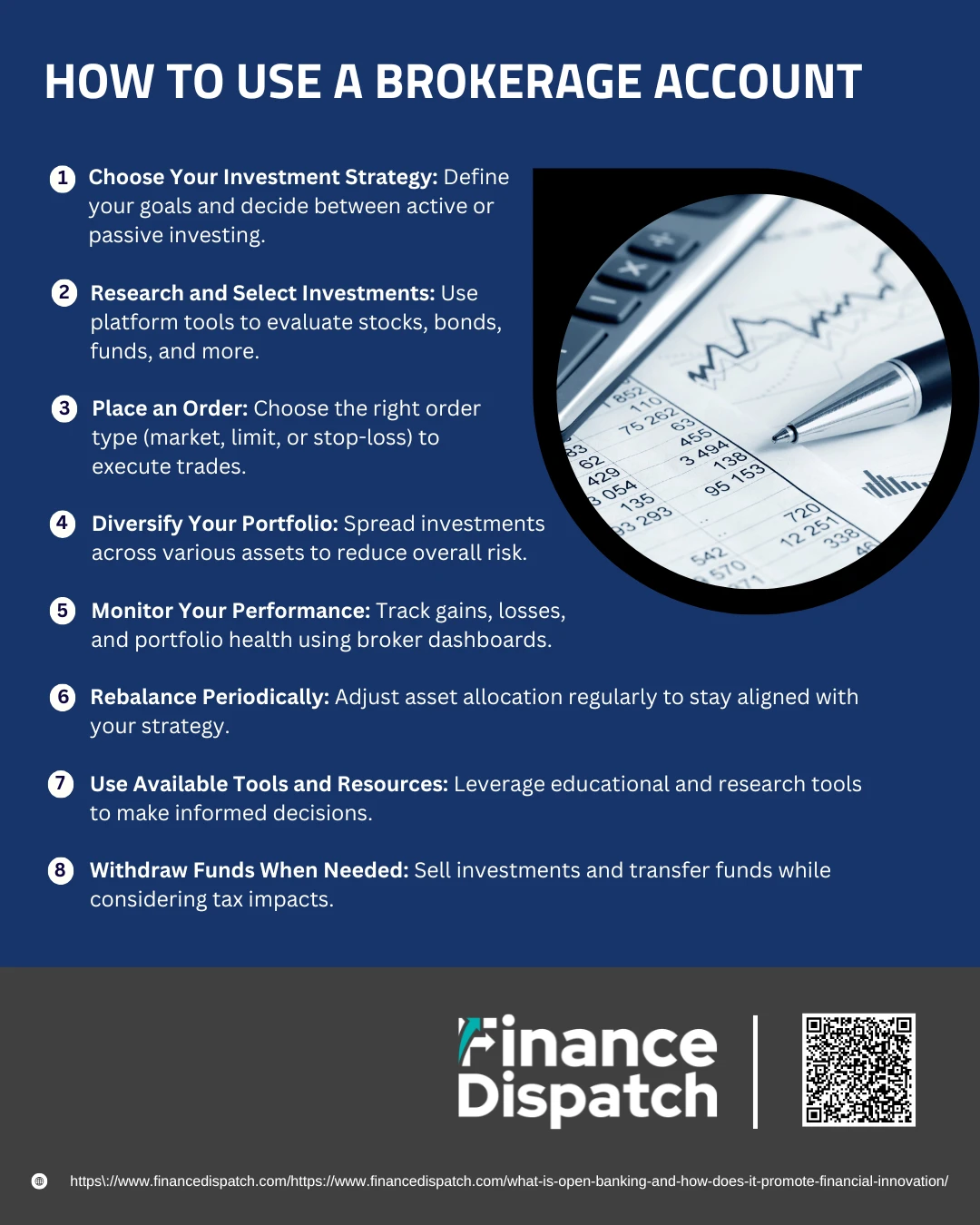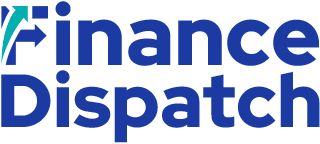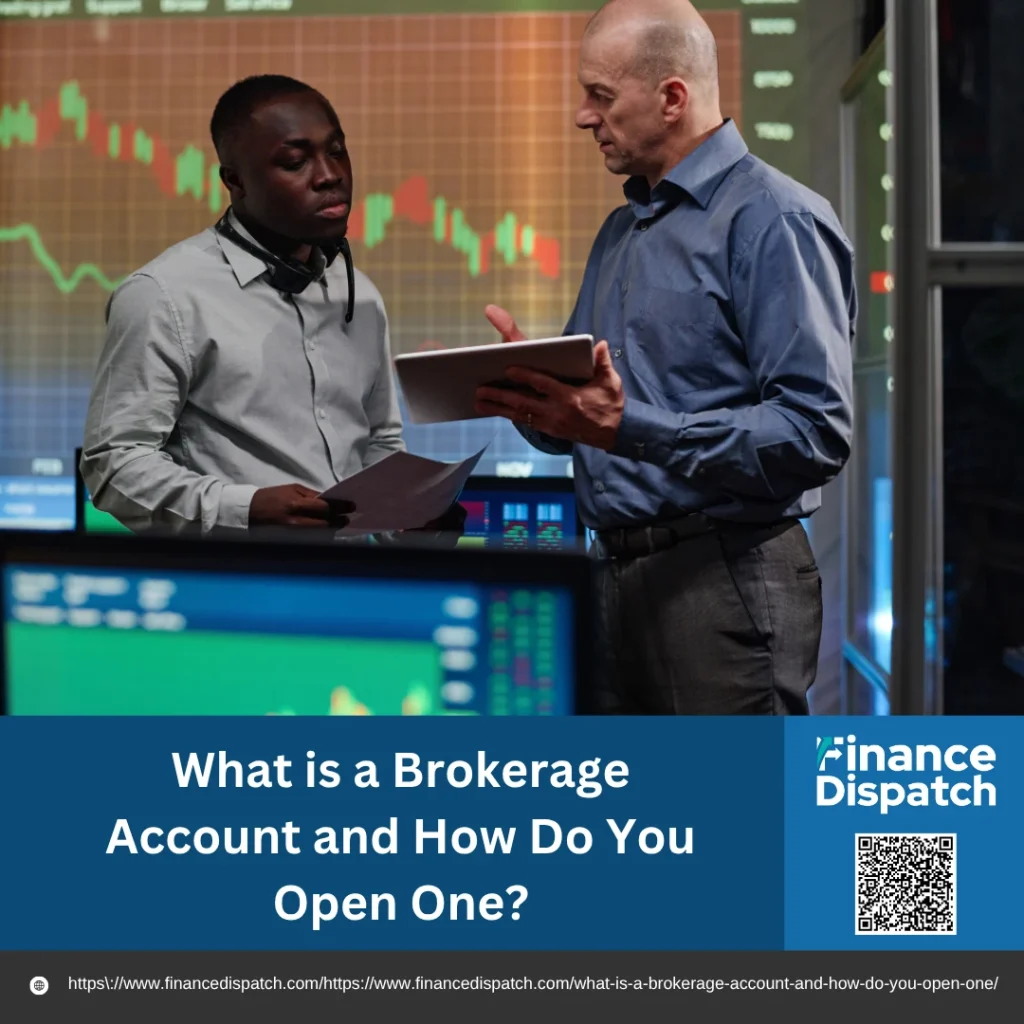If you’re thinking about investing in stocks, mutual funds, or ETFs, one of the first steps is opening a brokerage account. A brokerage account acts as a gateway between you and the financial markets, allowing you to buy, sell, and hold a wide variety of investments. Whether you’re planning for retirement, saving for a major purchase, or simply exploring ways to grow your wealth, understanding how brokerage accounts work—and how to open one—is essential for getting started on your investment journey.
What Is a Brokerage Account?
A brokerage account is a type of financial account that allows you to invest in a variety of securities, such as stocks, bonds, mutual funds, and exchange-traded funds (ETFs). You open this account through a licensed brokerage firm, deposit funds into it, and then use those funds to buy or sell investments. The brokerage acts as a middleman, executing trades on your behalf based on your instructions. Unlike retirement accounts, brokerage accounts offer unmatched flexibility—there are no contribution limits, withdrawal penalties, or income restrictions. This makes them a versatile tool for both short-term financial goals and long-term wealth building.
 Types of Brokerage Accounts
Types of Brokerage Accounts
When opening a brokerage account, it’s important to understand the different types available so you can choose one that aligns with your investment goals, risk tolerance, and level of involvement. Whether you’re a hands-on trader or prefer a more automated approach, there’s a brokerage account designed to fit your needs.
1. Cash Account
This is the most basic type of brokerage account. You can only make trades using the money you have already deposited. It doesn’t allow borrowing from the broker, which makes it a safer option for beginners.
2. Margin Account
A margin account lets you borrow money from your broker to buy more securities than you could with cash alone. While this can increase your potential returns, it also comes with higher risk, including the possibility of a margin call if your investments drop in value.
3. Individual Brokerage Account
Owned by a single person, this account gives full control to the individual, including decisions on trading, funding, and managing investments. All profits, losses, and tax responsibilities fall on the account holder.
4. Joint Brokerage Account
Shared between two or more people—typically spouses or family members—joint accounts allow equal access and control over the investments. Ownership types may vary, such as joint tenants with rights of survivorship or tenants in common.
5. Retirement Brokerage Account
These include accounts like Traditional IRAs or Roth IRAs, which are designed specifically for long-term retirement savings. They offer tax advantages but also have contribution limits and withdrawal restrictions.
6. Robo-Advisor Account
Ideal for hands-off investors, these accounts are managed by algorithms based on your risk tolerance and goals. They typically require lower fees and minimums, and include features like automatic rebalancing and tax optimization.
7. Custodial Account
Set up by an adult for a minor, custodial accounts allow parents or guardians to invest on behalf of a child. The assets legally belong to the child, who gains full control once they reach adulthood.
 Where to Open a Brokerage Account
Where to Open a Brokerage Account
Choosing the right place to open a brokerage account depends on how involved you want to be in managing your investments. Some platforms offer full control and low fees, while others provide professional guidance and personalized support. Here are the main options to consider:
1. Online Brokers
These platforms are ideal for do-it-yourself investors who want to research, buy, and sell investments on their own. They typically offer low or no trading fees, user-friendly websites or apps, and a wide range of investment options. Examples include Charles Schwab, Fidelity, and E*TRADE.
2. Robo-Advisors
Perfect for hands-off investors, robo-advisors use algorithms to build and manage a diversified portfolio based on your risk tolerance and financial goals. They often come with lower fees than traditional advisors. Popular choices include Betterment and Wealthfront.
3. Full-Service Brokers
These firms provide personalized investment advice and comprehensive financial planning. They assign you a dedicated advisor who can help with everything from retirement planning to tax strategies. However, these services usually come with higher fees and may require a minimum investment.
4. Bank Brokerage Services
Many traditional banks offer brokerage services through affiliated firms. This option can be convenient if you prefer to keep your banking and investing under one roof, though fees and investment choices may be more limited compared to standalone brokerages.
5. Mobile-First Investment Apps
Designed for newer or younger investors, these apps focus on simplicity and accessibility. They often support features like fractional shares and automatic investing. Examples include Robinhood and Acorns, though they may lack robust research tools or advanced features.
How to Choose the Right Brokerage Account
Selecting the right brokerage account comes down to your investment goals, experience level, and how much time you want to spend managing your portfolio. Whether you prefer a hands-on approach or want to let technology handle your investments, understanding the differences between account types can help you make an informed decision. Below is a comparison of key options to help you find the best fit.
| Feature | Online Broker | Robo-Advisor | Full-Service Broker |
| Cost | Low to zero trading fees | Moderate (typically 0.25%–0.50%) | High (may charge commissions or annual fees) |
| Investment Control | Full control | Limited – managed automatically | Shared with advisor or managed |
| Personalized Advice | Minimal or none | Algorithm-based recommendations | Extensive, human advisor-guided |
| Best For | DIY investors | Hands-off investors | Investors wanting expert guidance |
| Account Minimums | Often low or none | Varies; sometimes as low as $0 | Typically high |
| Available Features | Research tools, real-time trading | Auto-rebalancing, goal tracking | Estate planning, tax strategies |
| Ease of Use | Moderate to high | Very user-friendly | Depends on advisor & platform |
 How to Open a Brokerage Account
How to Open a Brokerage Account
Opening a brokerage account is your gateway to the world of investing. Whether you’re planning to grow your wealth over time, save for a major purchase, or build a retirement fund, this account gives you access to a wide range of investment options like stocks, mutual funds, ETFs, and bonds. The process is straightforward and can usually be completed online without any upfront fees. However, you’ll need to gather some personal and financial information beforehand and decide how involved you want to be in managing your investments. Here’s a more detailed breakdown of each step to help you get started confidently:
1. Decide on the Type of Account
Start by choosing between a standard taxable brokerage account and a retirement account like a Traditional or Roth IRA. If you’re saving for retirement, tax-advantaged accounts may be more beneficial. For more flexible goals, a standard brokerage account offers greater freedom.
2. Select a Brokerage Firm
Compare brokers based on fees, investment options, account features, and customer service. Consider whether you want a do-it-yourself platform (like Fidelity or Schwab), a robo-advisor (like Betterment), or full-service support from a human advisor.
3. Complete the Application
Most brokerage applications can be filled out online in 10–15 minutes. You’ll need to provide details such as your legal name, contact information, Social Security number, employment status, income, and investment goals. This helps the brokerage recommend suitable investments and comply with regulations.
4. Verify Your Identity
To meet legal and security standards, the brokerage will ask for a copy of a government-issued ID like a driver’s license or passport. This step helps prevent fraud and ensures you’re authorized to open an account.
5. Link a Bank Account
To fund your brokerage account, you’ll need to connect a checking or savings account. Most brokers use secure online systems for this, making it quick and easy to transfer money.
6. Fund Your Account
Once your bank account is linked, you can transfer money to your brokerage account. Some platforms may require an initial deposit, while others let you start with as little as $0. You can also set up recurring deposits for consistent investing.
7. Start Investing
With your account funded, you’re ready to choose investments based on your strategy and risk tolerance. You can manually select stocks and funds or let a robo-advisor build a diversified portfolio for you.
 How to Use a Brokerage Account
How to Use a Brokerage Account
Opening a brokerage account is just the first step—knowing how to use it effectively is what really empowers you as an investor. A brokerage account allows you to buy and sell a variety of investments, track your portfolio performance, and adjust your strategies over time. Whether you’re saving for retirement, a large purchase, or simply growing your wealth, understanding how to navigate your account will help you make smarter financial decisions. Below is a more detailed guide on how to use a brokerage account to its full potential:
1. Choose Your Investment Strategy
Before you start buying anything, it’s important to know your goals and approach. Are you investing for long-term growth, short-term gains, or consistent income? You can choose an active strategy where you research and pick your own investments, or a passive one where you rely on index funds or automated tools like robo-advisors.
2. Research and Select Investments
Use your brokerage platform’s research tools to explore different investment options. Look into stocks, bonds, mutual funds, and ETFs. Study their past performance, expense ratios, volatility, and how they align with your goals and risk tolerance.
3. Place an Order
Once you’ve chosen an investment, you’ll need to place a trade. Most platforms let you select from several order types:
- Market Order: Buys or sells immediately at the best available price.
- Limit Order: Sets a maximum (buy) or minimum (sell) price.
- Stop-Loss Order: Sells a security once it falls to a certain price to limit losses.
4. Diversify Your Portfolio
Avoid putting all your money into one investment. Diversification—spreading your money across different asset classes and industries—helps reduce risk and smooth out potential losses over time.
5. Monitor Your Performance
Track how your investments are doing using your broker’s performance dashboard. Keep an eye on gains, losses, dividends, and how each asset contributes to your overall goals. Many brokers offer real-time charts, alerts, and news updates.
6. Rebalance Periodically
As markets fluctuate, your portfolio may shift away from your original plan. Rebalancing—adjusting the mix of assets back to your target allocation—helps maintain the level of risk you’re comfortable with. This might involve selling some investments and buying others.
7. Use Available Tools and Resources
Take full advantage of your brokerage’s built-in resources, such as educational articles, video tutorials, investment screeners, and analyst reports. These tools can help you make more informed decisions and learn as you grow.
8. Withdraw Funds When Needed
You can sell investments and transfer the cash back to your bank account whenever you need it. However, be mindful of potential tax implications from selling investments at a profit, as well as any withdrawal or transaction fees.
Taxes and Brokerage Accounts
While brokerage accounts offer flexibility and control, they also come with tax responsibilities. Unlike retirement accounts, brokerage accounts are considered taxable, meaning you may owe taxes on investment income such as capital gains, dividends, and interest. Understanding how these taxes work can help you plan smarter and potentially reduce your tax burden. Here are the key tax considerations for brokerage account holders:
1. Capital Gains Taxes
When you sell an investment for more than you paid, the profit is considered a capital gain and is taxable. The rate depends on how long you held the asset:
- Short-term capital gains (held for one year or less) are taxed at your regular income tax rate.
- Long-term capital gains (held for more than a year) are taxed at reduced rates of 0%, 15%, or 20%, depending on your income.
2. Capital Losses and Tax-Loss Harvesting
If you sell an investment at a loss, you can use that loss to offset gains and reduce your taxable income. This strategy is known as tax-loss harvesting, and it can be especially helpful during market downturns.
3. Dividends
Earnings distributed by stocks or mutual funds are called dividends. These are generally taxable in the year they are received:
- Qualified dividends are taxed at the lower long-term capital gains rate.
- Ordinary dividends are taxed at your regular income tax rate.
4. Interest Income
Interest earned from bonds or uninvested cash in your account is taxed as ordinary income.
5. Form 1099
Each year, your brokerage will send you a 1099 form summarizing your investment earnings. You’ll need this when filing your tax return to report gains, dividends, and interest.
- No Tax Benefits on Contributions
Unlike retirement accounts, money contributed to a brokerage account is not tax-deductible.
Brokerage Account vs Retirement Account
When deciding where to invest your money, it’s important to understand the key differences between a brokerage account and a retirement account. Both allow you to grow your wealth through investments, but they serve different purposes and come with unique tax treatments, contribution rules, and withdrawal guidelines. Knowing how each one works can help you choose the best option—or combination—for your financial goals.
| Feature | Brokerage Account | Retirement Account (IRA, 401(k), etc.) |
| Primary Purpose | General investing for any financial goal | Saving specifically for retirement |
| Tax Benefits | Taxable; no upfront or deferred tax benefits | Offers tax-deferred or tax-free growth |
| Contribution Limits | No limits on how much you can invest | Annual contribution limits apply |
| Withdrawal Rules | Withdraw anytime without penalties | Early withdrawals may trigger taxes and penalties |
| Access to Funds | Full access anytime | Limited access until age 59½ (exceptions apply) |
| Employer Match | Not available | Often available in 401(k) plans |
| Use of Funds | Flexible—can be used for any purpose | Intended for retirement use only |
| Tax on Gains | Capital gains and dividends are taxed | Taxes depend on account type (traditional vs Roth) |
 Pros and Cons of a Brokerage Account
Pros and Cons of a Brokerage Account
A brokerage account is one of the most flexible and accessible ways to begin investing. It allows you to buy and sell a wide variety of financial assets, from stocks and bonds to mutual funds and ETFs, without the restrictions typically found in retirement accounts. Whether you’re saving for a long-term goal like a home or planning to grow wealth over time, a brokerage account can be a valuable part of your financial strategy. However, it’s important to understand both the benefits and limitations before opening one. Here’s a closer look at the main pros and cons:
1. Pro: No Contribution Limits
Unlike IRAs or 401(k)s, there’s no cap on how much money you can put into a brokerage account each year. This makes it a great option for high earners or anyone looking to invest beyond the limits of tax-advantaged accounts.
2. Pro: Easy Access to Funds
Brokerage accounts offer full liquidity. You can withdraw your money at any time without paying early withdrawal penalties, which is ideal if you want access to your funds before retirement age or for unexpected expenses.
3. Pro: Wide Range of Investment Options
From individual stocks to complex ETFs, you have access to nearly all publicly available investment products. This allows for greater diversification and more control over how you build your portfolio.
4. Pro: No Income Restrictions
Anyone can open and contribute to a brokerage account regardless of how much they earn. This contrasts with some retirement accounts, like Roth IRAs, which have income-based eligibility rules.
5. Con: Taxable Earnings
One of the biggest downsides is that earnings in brokerage accounts are taxable. Capital gains, interest, and dividends are all reported on your annual tax return, which can reduce your net returns.
6. Con: No Tax-Deferred Growth
While your investments can grow over time, any realized gains are taxed in the year they occur. You don’t get the benefit of deferring taxes until retirement, as you do with traditional IRAs or 401(k)s.
7. Con: No Employer Match
Employer-sponsored retirement accounts often come with matching contributions—essentially free money. Brokerage accounts don’t offer this perk, so you’re solely responsible for building your investment balance.
8. Con: Market Risk
Like any investment, there is no guarantee your assets will grow. Brokerage accounts are subject to market ups and downs, and poor investment decisions can result in losses. Without diversification and a sound strategy, the risk can be significant.
When to Consider Opening One
You should consider opening a brokerage account when you’ve built an emergency fund, paid off high-interest debt, and are ready to invest money for goals beyond retirement. If you’ve already maxed out contributions to tax-advantaged accounts like a 401(k) or IRA, a brokerage account offers a flexible way to continue growing your wealth without contribution limits. It’s also a smart choice if you’re saving for medium- to long-term goals—such as buying a home, funding a child’s education, or pursuing early retirement—because you can access your funds at any time without penalties. Whether you prefer to manage your own investments or use a robo-advisor, a brokerage account gives you full control over how, when, and where your money is invested.
Conclusion
A brokerage account is a versatile and powerful tool for anyone looking to take control of their financial future. It offers the freedom to invest in a wide range of assets, from stocks and bonds to mutual funds and ETFs, with no contribution or withdrawal restrictions. While it lacks the tax advantages of retirement accounts, its flexibility makes it ideal for both long-term and short-term investment goals. Whether you’re an experienced investor or just getting started, understanding how brokerage accounts work—and how to use them wisely—can help you grow your wealth and reach your financial objectives with confidence.



